Battle of the Danube. H. 2
The detachment of the Turkish ships that was at Machin did not show any special activity, only from time to time shelling Russian positions. 29 of April (11 of May) 1877 of an armored corvette Lutfi Djelil, which did not have an armored deck, was killed by the outboard fire of Russian Brailovo coastal batteries. He received two hits at the same time, from an 24-pound cannon and an 6-inch mortar, and sank at a 22-meter depth after a strong explosion. The sinking of the Turkish ship was evidence of the high art of the Russian artillerymen. The command was awarded: Lieutenant S. I. Samoilo (Order of Vladimir 4 degree with swords) and gunners ordinary Roman Davidyuk and Ivan Pompor (signs of the Military Order).
The death of "Lutfi Jelil" demoralized the Turks. The Danube Flotilla retreated into the depths of the Machinsky arm. Using the favorable atmosphere, the Russian sailors barred mines from the northern exit from the arm, as well as the channel of the Danube from Brailov. Turkish ships were isolated. As a result, the Russians were able to establish their shipping on the Reni-Brailov section. It was decided to take action against the enemy ships, which had taken refuge in Machinsky arm, by mineships, having previously closed the southern exit. Due to the lack of mines, they decided to go for a military trick, a demonstrative staging: sandbags were dropped from boats. The Ottomans were misled.
The explosion of the Turkish battleship "Lutfi-Jelil" on the Danube 29 April 1877. A.P. Bogolyubov
15 (27) May operation began. Four mineboats in slow motion entered the Machinsky sleeve. They stayed at the shore to ensure stealth movement. In 2 hours 30 minutes they found a Turkish squad. In the middle was the monitor "Seyfi" (Selfi) with a displacement of 410 tons, and along its sides - the wheelboat "Kilidzhi Ali" and the armored gun "Fehthul Islam". The main object of the attack was the monitor. He went to the boat "Tsarevich", supported by boats "Xenia" and "Dzhigit." The boat "Tsarevna" was in reserve. At a distance of 126, the boats went full speed. The first attacked "Tsarevich" under the command of Lieutenant F. V. Dubasov. The Turks noticed the boat when no more than 60 meters were left to the monitor, and tried to open gunfire at it, but all hurried attempts to make cannons fired misfired. The boat hit with its pole mine in the stern of the Turkish ship, but he, although he received a hole, remained afloat. During the attack, the boat in the explosion took water and was barely able to get around a short distance. He temporarily lost his stroke and pumped water to raise steam in the boilers. At this time, the Turkish ship attacked the boat "Xenia" under the command of Lieutenant A.P. Shestakov and hit mine in the middle of the ship. There was an explosion and "Safe" went to the bottom. After the attack, the Russian boat almost died, entangled by a screw in the rigging of a sinking ship.
“Djigit” at this time received a hole in the stern of a shell fragment, and the explosion of the second projectile almost completely flooded the boat with water. The crew had to stick him to the shore, fill the hole and bail out water. The fourth participant of the operation - the boat "Tsarevna" - was unable, under the fierce fire of the two remaining Turkish ships, to approach them at a distance of a pole. Boats lay on the reverse course. Among the Russian crews there were neither killed nor wounded.
Bogolyubov A.P. The explosion of the Turkish monitor "Safe" on the Danube
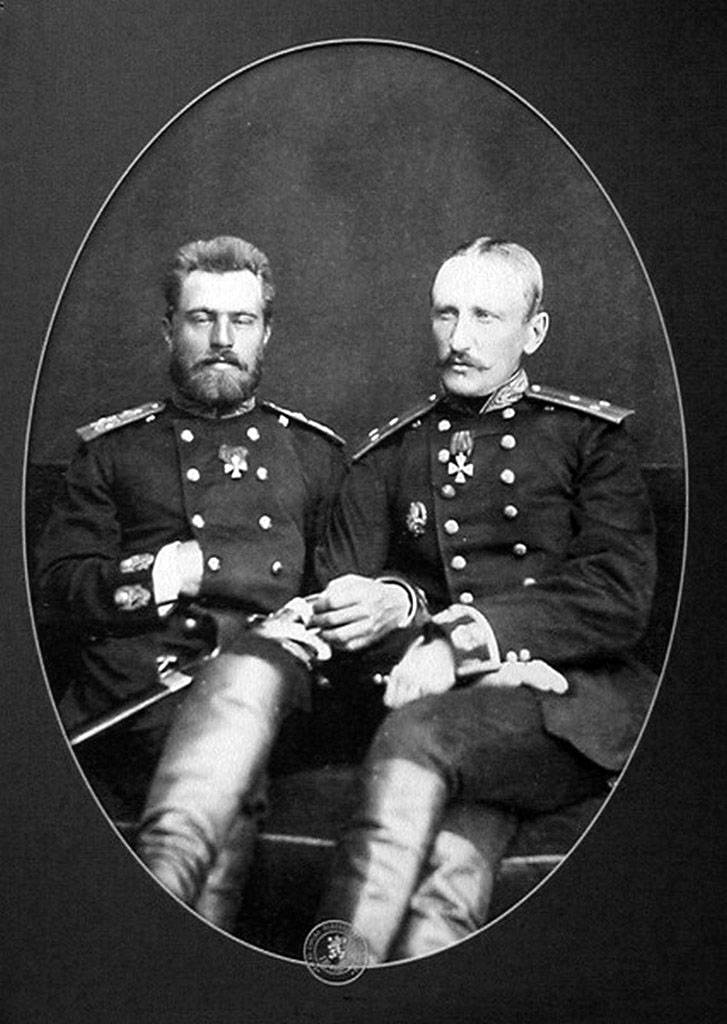
The first St. George Knights of the War 1877-1878, Lieutenants Dubasov and Shestakov. 1877 year
Thus, the attack "Safe" became the first in stories naval art is a successful example of a night group battle of mine boats. The attack was carried out under fierce artillery and rifle fire of the enemy, on the whole disorderly, otherwise the battle could have ended differently. This fight testified to exceptional stamina and courage of Russian sailors. For the sinking of "Seyfi" lieutenants Dubasov and Shestakov were awarded the Order of George of the 4 degree. All officers who participated in the attack received awards. The lower ranks were marked by signs of the Military Order. The successful attack of the enemy ship with the help of a pole mine was not limited to tactical success. The death of the monitor caused panic among the personnel of the Turkish flotilla and influenced the whole course of the battle for the Danube. The Turks were completely demoralized, their ships ran upriver under the protection of the batteries of Silistria.
5 (17) in May, a minefield was placed at the southern exit of Machinsky arm, 28 in May (9 June) - north of Girsovo. As a result, the entire area of the Lower Danube from Reni to Girsovo was cleared from the enemy and controlled by the Russian army. Total on the Danube put more than 500 min. 28 on May 1877 of the year, on the roads of the Romanian port of Sulin, the boats Makarov exploded mines from the Turkish battleship “Iklalye”, and on June 8 they sank the brig Osmaniye and 3 on a small steamboat.
The struggle for supremacy on the Middle Danube began with the release of the Russian army to the river. The Russians began to build batteries. They were given the task of preventing the Turkish flotilla from passing to the area of the main crossing and bombard Ruschuk and Nikopol, to cover the mining of the river. At the same time, the sailors set about setting up minefields. The detachment of the Guards crew operating there was divided into two parts for simultaneous laying of mines on both flanks of the intended section of the crossing, near the island of Mechka and near the village of Corabia. Attempts by the enemy to prevent the setting of minefields were reflected by the fire of coastal batteries and the attacks of mineboats.
So, 8 (20) June, the enemy sent an armed ship, which opened fire on Russian minerals. The commander of the Russian detachment of boats, Captain 1 of the rank of M. D. Novikov, gave a signal to "Joke" to attack him. Boat commanded by Lieutenant N. I. Skrydlov. As a volunteer assistant miner on it was the Russian artist V. V. Vereshchagin. At full speed the boat came out of the ambush in the thickets of reeds, went to the starboard side of the steamer and hit him with a pole mine behind the paddle wheel. Due to the damage, the fuse did not work, and the strong current pressed the boat to the enemy's side so that the mine pole broke down. The Turks, who came to their senses, began to shoot “Joke” from manual weapons and wounded the commander and one of the sailors. In spite of the shooting from the ship, the Russian sailors could put their hands on the side of the ship to push the boat and back up. The Russian sailors could not destroy the enemy ship, but they gave the opportunity to the minerals to complete their work on the installation of obstacles. By mid-June, it was possible to insulate the site of the main crossing from both flanks with mines. Ships of the Turkish flotilla were pushed aside under the protection of the artillery Ruschuka and no longer appeared in the area.
Thus, despite the inequality in forces, and the presence of strong "trumps" among the Turks, the skillful use of Russian mine weapons, boats, artillery allowed the Russian army to seize the great river. This made it possible to create favorable conditions for forcing the Danube. Mine weapons made the most affordable and strong defensive and offensive weapons. The British naval experts were convinced of the absolute superiority of the Turkish armored fleet, believing that Russian sailors, at best, could only provide some protection for their bases and the coast. However, the Russian sailors were able to paralyze the actions of a strong Turkish Danube flotilla and the Turks were unable to use their advantage on the river in order to disrupt or at least seriously delay the advance of the Russian army.
Bogolyubov A .P. Attack of the Turkish steamer with the 16 June Joke 1877
Force preparation
The Russian command decided first to ferry the forward (landing) squad as part of the reinforced 14 th rifle division under the command of Major General M. I. Dragomirov. Division reinforced the other parts: 4-th Infantry Brigade, the consolidated company of the honorary escort, two hundred Plast, 23-m Don Cossack Regiment, 14-rd and 9-Artillery Brigade and 2 mountain batteries (more than 16 battalions, 6 hundreds, 64 tools). 4 pontoon battalions, a fleet of pontoons, a crew of sailors in 334 man and a hundred Ural Cossacks were selected for the transfer (they chose the most skilled rowers and swimmers).
The commander of the 3 th sapper brigade, Major General A. K. Richter, who was assigned the engineering support of the forcing, established the following order: to transport the infantry on iron pontoons, artillery and cavalry on ferries. There were a total of 36 bastard and 32 conventional pontoons and 6 ferries. On the one-and-a-half pontoon there were 45 infantrymen, on the usual one - 30. In each battalion, the 2 allocated normal pontoons to the reserve. They were nurses and swimmers with life buoys and ropes. The pontoons, located in Zimnitsa, were to be launched into the canal that flowed south of the town and led along them to the landing point in the Danube. Then the pontoons were to bypass the island of Addu from the east and keep the direction on the mouth of the Tekir-Dere creek, where the landing of troops was planned.
The ferry was planned on 7 flights. On one flight, including the landing and the return of the pontoons, was given 2 hours. At each echelon, the 12 mouth, 60 Cossacks and 8 guns should be shipped. The first echelon consisted of the 2 battalion and all the rifle companies of the 53 Infantry Regiment of Volyn, hundreds of rafts, 60 Cossacks and a mountain battery. Its total number is 2,5 thousand people. The first echelon was to ensure the landing of subsequent echelons by seizing the line west of the mouth of the Tekir-Dere stream. The overall task of the forward detachment was to capture the bridgehead and to ensure the crossing of the main forces of the Danube army. Also provided artillery and infantry training landing. Two companies of the 35 Infantry Regiment of the Bryansk Regiment occupied the island of Buzhiresku, covering the area where the troops landed in the pontoons. The remaining companies of this regiment and six batteries of the 14 and 9 artillery brigades (48 guns) were secretly located along the left bank of the Danube in order to support the assault force to capture and expand the bridgehead. Part of the artillery was allocated for the direct support of infantry combat in the bridgehead.
The talented general M.I. Dragomirov played a major role in the implementation of the preparatory work on the forcing of the Danube. He was considered an expert in this matter. Dragomirov was the author of the work "On the landing in ancient and modern times." Dragomirov carefully prepared for the landing of his squad. 9 - 12 (21 - 24) June, the troops conducted pontoons, overcoming the river, and actions on the right bank. A reconnaissance was held with the commanders of the mouth of the 53 Volynsky Regiment assigned to the first voyage.
All measures to prepare the crossing of the Danube tried to be carried out covertly. In Turkey, England, Austria-Hungary and other countries closely followed the actions of the Russian army. Opponent and Western "partners" used undercover and press information. Despite the warnings of the Russian command, the British correspondents with great accuracy gave data on the number and deployment of Russian troops. The situation on the railways was studied, special attention was paid to landing craft. To deceive the enemy, the Russian command used misinformation. In particular, in order to divert Turkish attention from the direction of the main attack, on the night of 10 (22) in June 1877 in the Galati and Brailov region, the Danube Nizhnedunaysky detachment (14 army corps) of General A.E. Zimmerman began to cross. An attempt by the Ottoman troops to prevent this failed. Having overcome the Danube and having broken the resistance of the enemy, the Russian troops by the end of 10 (22) in June firmly occupied the Budjak peninsula. The Turks withdrew to Machin, and then to the Chernovody and Kyustendzhi line. The local population enthusiastically greeted the Russians. The losses of the Russian troops in this operation were relatively small: 139 soldiers and officers killed and wounded.
Almost simultaneously with the forcing of the Danube, the Lower Danube detachment spread a rumor that the crossing of the main forces of the Russian army would take place at the Flamunda. The commander of the 9 Corps, General N. P. Kridener, was ordered to start the crossing in the Nikopol 15 (27) area in June. Russian and Romanian artillery on the left bank of the Danube received the task 12 - 15 of June to fire on Turkish positions and fortresses. Ruschuk and Nikopol fired day and night. Here were first used spotlights ("electric lights"). Particularly actively fired upon Nikopol, in the area of which the main forces of the Russian army were supposed to force the river. The headquarters of the commander in chief pointedly left the forcing area. The troops approached Zimnitsa only on the night of June 14 (26), carefully observing the disguise. The concentration area was guarded by the Cossacks.
Thus, the Turkish command misled. The commander-in-chief of the Danube Turkish army, Abdul Karim Pasha, who visited Sistovo, pointed to the palm of his hand, told the retinue: “It’s rather that my hair grows here than the Russians will cross the Danube here.” As a result, the crossing of the Russian troops at Sistovo became sudden for many, not only for the Ottomans, but also for the Russians and the press.
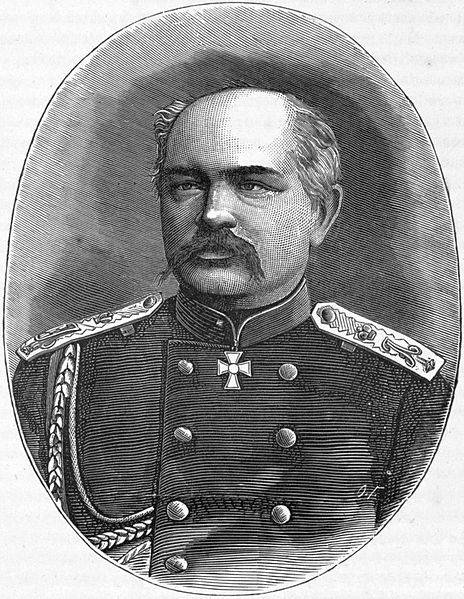
Commander of the 14 Division Mikhail Ivanovich Dragomirov
Crossing the main forces
By 14 (26) June 1877, preparatory measures were taken to force the Danube by the main forces of the Russian army. The four corps of the Russian army (8, 9, 12 and 13) intended for the offensive were concentrated in the region north and north-west of Zimnitsa. The vanguard was ready to cross. The 11 Corps received the task of defending the Danube frontier from Zimnitsa to Kalarash, while maintaining contact with the Lower Danube detachment.
At midnight, from 14 to 15 (26 - 27) on June 1877, the landing of the first echelon began. At 2 15 (27), the crossing of June began. In the darkness, the movement of the pontoons was upset because of the wind and high speed of the current, and the first two companies landed somewhat west of the Tekir-Dere brook. At about 3 hours the train completed ferries, knocked down Turkish posts and took up a position. At dawn, the vanguard began to expand the springboard. Meanwhile, Turkish troops from Vardam and Sistovo were approaching the crossing. When the Russian troops crossed Tekir-Dere and partially reached the heights on the eastern coast, they were attacked by the enemy in the flank and rear. The Russians went on a bayonet attack and with the support of six mountain guns threw the enemy. Russian soldiers occupied heights. However, soon the Turks, reinforced by suitable reinforcements, attacked again and began to push our troops to the stream. The position of the advanced Russian troops was extremely difficult.
The commander of the 8 Corps, Lieutenant-General FF Radetsky, who arrived in the area of the crossing, ordered that the rest of the reinforced Dragomirov's division be rerouted not as full trains, but porotno, as the pontoons returned. The landing site was moved 2 km down the river (opposite the mouth of Tekir-Dere), which accelerated the crossing and provided quick support to the first echelon. The attempt of the Turks to prevent the crossing with artillery fire was not crowned with success. The Russian batteries from the north bank of the Danube began shelling the Turkish positions, and thwarted the enemy’s attempt to conduct concentrated fire on the troops that had been dispatched. As a result, by the 6 clock all the attacks of the Turkish troops were repulsed and the Ottomans retreated. Russian troops captured and held a bridgehead.
At 8 hours 30 minutes approached the ship "Annette" with two towed barges. This vessel, previously deliberately flooded at Nikopol, was lifted out of the water on the night of the forcing and delivered to the crossing area. The ship was led by sailors of the Guards crew. The transfer of troops went faster. Soon the entire forward detachment was on the left bank of the Danube. To expand the bridgehead, it was necessary to take Sistovskiy heights. Dragomirov entrusted this task to the 2 Brigade of the 14 Division and the 4 Brigade. The 1 Brigade of the 14 Division provided a bridgehead from the southeast. The offensive began around 11 hours and by 15 hours Sistovo and the surrounding heights were occupied by Russian troops. On the same day, the main forces of the Russian army began to force the Danube. By the evening of June 15 (27), the bridgehead had 29 battalions and 30 guns. On the morning of June 16 (28), Russian troops occupied Wardes.
"The crossing of the Russian army across the Danube at Zimnitsa 15 June 1877 of the year." N. D. Dmitriev-Orenburg
According to A. B. Shirokorad, the Russian casualties were 748 people killed, drowned and wounded, and two drowned guns. Military historian A. A. Kersnovsky cites a slightly large number - 1100 people, of whom 320 are dead.
After the bridgehead was captured, the construction of bridges began. The necessary pontoons and other materials were brought from the mouth of the Olta to Zimnitsa. The construction of the first bridge ended on June 19 (July 1). The bridge passed through about. Adda and consisted of two parts with a total length of about 1200 m. From 20 June, troops and cargo began to cross it. The second bridge, higher than the first, was commissioned on June 29 (July 11). He was called the top. The bridge, which passed through the islands of Bužirescu and Adda, consisted of three parts with a total length of over 1200 meters. The bridge bridges ensured the rapid transfer of the main forces of the Danube army.
Thus, in general, the operation on the forcing of the Danube was held at a high level. For a long time this experience served as a successful example in studying methods of overcoming major water barriers. The success of the operation was achieved thanks to the correct choice of the area of the crossing, the courage and dedication of Russian sailors, soldiers and officers. The personnel - sailors, gunners, engineers and infantrymen, showed a high combat training. A special role was played by Russian sailors. It is also worth noting the mistakes of the Turkish command, which could not use the strengths of the Danube frontier (a large water barrier, strong fortresses, the Danube flotilla).
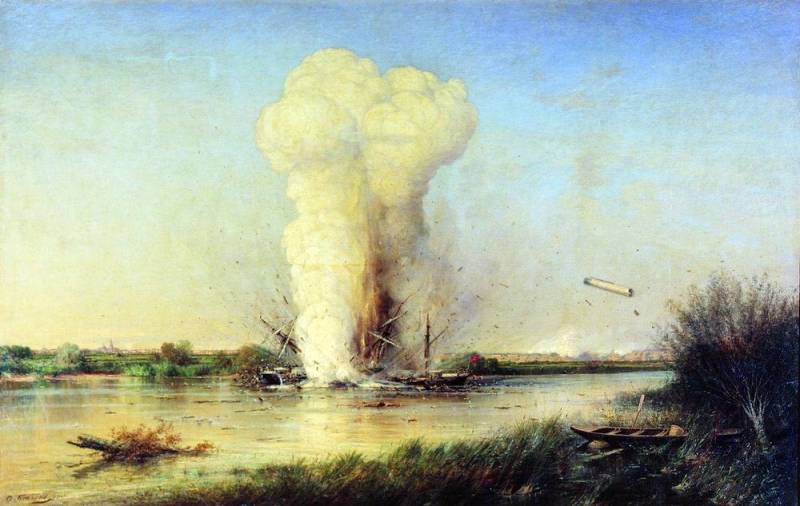
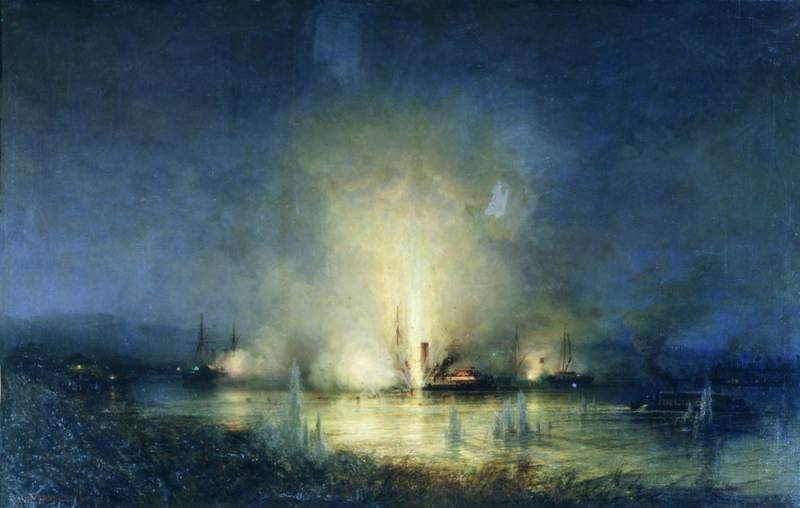
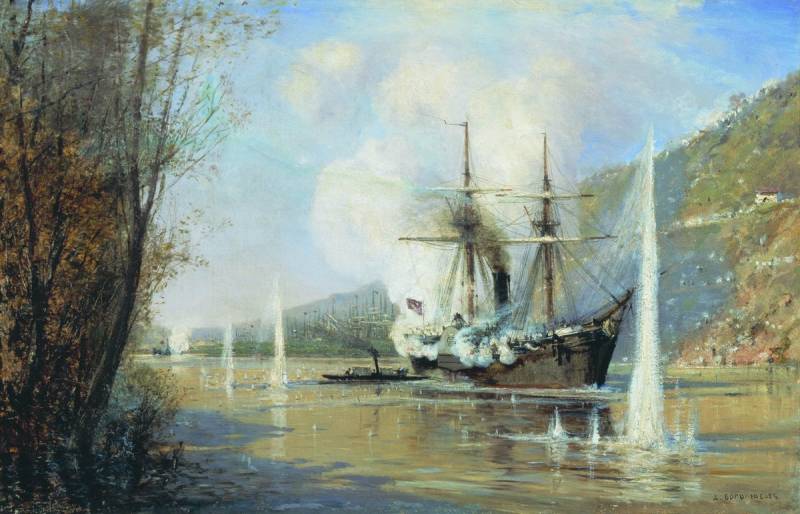
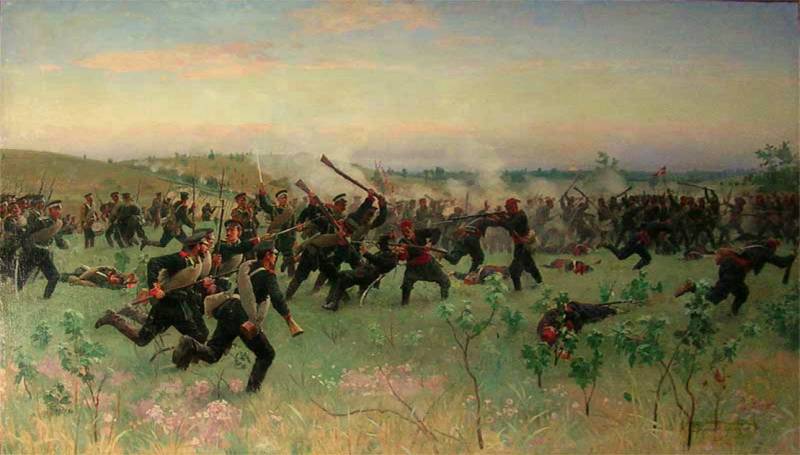
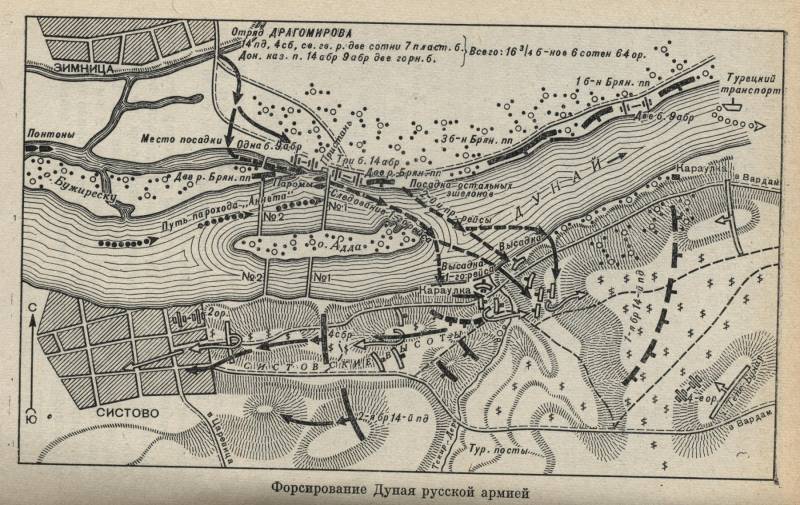
Information